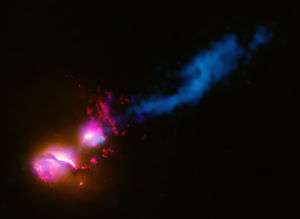3C 321
| 3C 321 | |
|---|---|
 Galaxy system 3C 321. A stream of energy is erupting from the "Death Star Galaxy" at bottom-left, striking its companion galaxy at top-right. | |
| Observation data | |
| Constellation | Serpens |
| Right ascension | 15h 31m 42.7s |
| Declination | +24° 04′ 25.00″ |
| Redshift | 0.0961[1] |
| Distance |
1.2 billion ly (370 Mpc) (Light travel time)[1] |
3C 321 is a system of two galaxies rotating around each other. They are notable for showing the first observed galaxy smiting another galaxy with a blast of energy, which is theorized to be from a supermassive black hole at the center of the former galaxy.
The larger galaxy, dubbed the "Death Star Galaxy" by NASA astronomers, has an energetic jet directed towards its companion. The discovery was announced by NASA on 18 December 2007. Observation of the enormous jet was possible due to the combined efforts of both space and ground-based telescopes.
Tools included NASA's Chandra X-ray Observatory, Hubble Space Telescope, Spitzer Space Telescope, the Very Large Array, and the Multi-Element Radio Linked Interferometer Network.
References
- 1 2 "NASA/IPAC Extragalactic Database". Results for 3C 321. Retrieved 2010-04-26.
Further reading
- Hautaluoma, Grey; Morcone, Jennifer; Watzke, Megan (17 December 2007). "'Death Star' Galaxy Black Hole Fires at Neighboring Galaxy". NASA.
- Phillips, Tony (18 December 2007). "NASA Announces Discovery of Assault by a Black Hole". Science@NASA. NASA.
- Mosher, Dave (17 December 2007). "Galaxy Blasts Neighbor with Deadly Jet". Space.com.
- O'Hanlon, Larry (17 December 2007). "Galaxy Zapping Neighbor With Deathly Beam". Discovery News. Archived from the original on 19 December 2007.
External links
- "Black Hole Fires at Neighboring Galaxy" at Harvard University's Chandra Photo Album
- Source page for 3C321 at Extragalactic.info
- An Atlas of DRAGNs: 3C 321 by the Jodrell Bank Centre for Astrophysics
This article is issued from
Wikipedia.
The text is licensed under Creative Commons - Attribution - Sharealike.
Additional terms may apply for the media files.